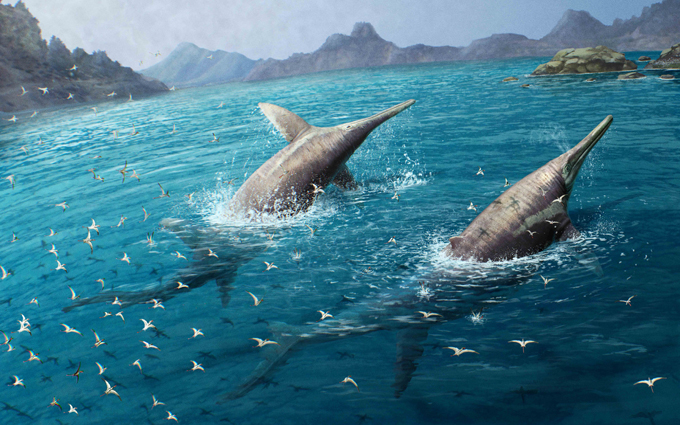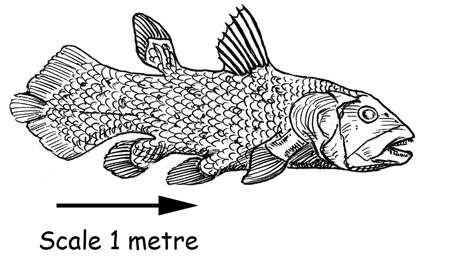Unique Insight into an Ancient Late Triassic Landscape
Researchers, including scientists from the University of Bristol have undertaken extensive fieldwork to determine the fauna of a Late Triassic landscape. The excavation and study of hundreds of microvertebrate fossils from Lavernock Point (close to Cardiff and Penarth), has enabled the research team to construct a picture of the palaeoenvironment of South Wales around 200 million years ago.
A Terrestrial Environment Close to a Tropical Sea
Dinosaurs and other tetrapods lived on a tropical lowland beside the sea. Dinosaur trackways are known from Barry and other sites close to Lavernock Point. These trace fossils and the recent discovery of dinosaur bones has helped shed light on the history of dinosaurs in Wales.

Evidence of dinosaurs in the Late Triassic landscape of South Wales. A tridactyl (three-toed) footprint, one of many trackways and prints associated with the Dinosauria known from South Wales. Picture credit: Cindy Howells at the National Museum of Wales.
A Late Triassic Landscape
The cliffs at Lavernock Point contain shales and limestone deposits that were laid down in a warm, tropical sea. Bonebeds are found at several levels of the strata. These locations contain the remains of fish including sharks, marine reptiles and occasionally dinosaurs.
Whilst most of the dinosaurs were small, when compared to their Jurassic descendants, recent marine reptile discoveries indicate that there were giants in the ecosystem. For example, fossilised jawbones indicate the presence of enormous ichthyosaurs, some of which may have been the size of the largest extant whales.
To read a recent blog post about giant Triassic ichthyosaurs: Ichthyotitan A Colossus of the Late Triassic.
Owain Evans, a former student at Bristol University led the research.
He explained:
“The bone bed paints the picture of a tropical archipelago, which was subjected to frequent storms, that washed material from around the surrounding area, both in land and out at sea, into a tidal zone. This means that from just one fossil horizon, we can reconstruct a complex ecological system, with a diverse array of marine reptiles like ichthyosaurs, plesiosaurs and placodonts in the water, and dinosaurs on land.”

A giant pair of Ichthyotitan severnensis. Giant marine reptiles swam in the shallow seas surround a tropical archipelago. Picture credit: Gabriel Ugueto.
The researcher added:
“I had visited the coast at Penarth all my life, growing up in Cardiff, but never noticed the fossils. Then, the more I read, the more amazing it became. Local geologists had been collecting bones since the 1870s, and most of these are in the National Museum of Wales in Cardiff.”
Continuing the Research Begun in the 19th Century
Cindy Howells, the Curator of Palaeontology at the National Museum of Wales (Cardiff) highlighted the significance of the fossil discoveries at Lavernock Point. The strata and the fossils contained therein have been studied since the 19th century.
Cindy commented:
“The presence of dinosaur fossils at the site ensure that it remains one of the most significant localities for palaeontology in Wales.”
Two Important Discoveries
Two significant discoveries were made by the research team during the fieldwork at Lavernock. Firstly, an osteoderm from a placodont was discovered. Placodonts were a type of marine reptile that thrived during the Triassic. Secondly, a gular bone from the skull of a coelacanth was found.
Co-author of the scientific paper and the research supervisor Dr Chris Duffin explained:
“The remains of coelacanths and placodonts are relatively rare in the UK, which makes these finds even more remarkable. These two fossils alone help build a broader picture of what the Rhaetian in the UK would have looked like.”

A scale drawing of a Coelacanth. The gular bone is located between the dentaries of primitive fish such as Coelacanths. Picture credit: Everything Dinosaur.
Picture credit: Everything Dinosaur
Dinosaurs of the Late Triassic Landscape
Professor Michael Benton from Bristol’s School of Earth Sciences, another co-author of the study added:
“The volume of dinosaur remains found at Lavernock is extremely exciting, and is a chance to study a complex, and often mysterious period in their evolutionary history. We have identified the remains of a large Plateosaurus like animal, along with several bones which likely belonged to a predatory theropod.”
This is exciting news, team members at Everything Dinosaur are looking forward to hearing more about these recent dinosaur fossil discoveries. Perhaps, a new species of Welsh sauropodomorph will be described.
The majority of the study focuses on the abundant microfossils found in the cliffs. These fossils include fish teeth, scales and bone fragments. By studying thousands of fossils, the research team were able to identify the key species that lived in the tropical sea. In addition, the team can estimate relative population densities. This permits them to construct food webs and learn more about the fauna present in the Late Triassic landscape. It is likely that more dinosaur fossil discoveries will be made in the future.
Everything Dinosaur acknowledges the assistance of a media release from the University of Bristol in the compilation of this article.
The scientific paper: “Microvertebrates from the basal Rhaetian Bone Bed (Late Triassic) at Lavernock, South Wales” by Owain Evans, Christopher J. Duffin, Claudia Hildebrandt, and Michael J. Benton published in the Proceedings of the Geologist’s Association.
The Everything Dinosaur website: Dinosaur and Prehistoric Animal Toys.

